We’ve seen only three anglers break the legendary 22-pound largemouth bass barrier: George Perry (22-4, 1932), Manabu Kurita (22-5, 2009), and Robert Crupi (22-0, 1991). Southern California has become a trophy bass hotspot since the 1980s, with several monsters caught even during winter months. Not all big catches make the record books though—some get disqualified for violations like fishing without a license. Techniques have evolved dramatically from Perry’s simple approach to today’s high-tech methods.
The Legendary 22-Pound Club: Perry, Kurita, and Crupi
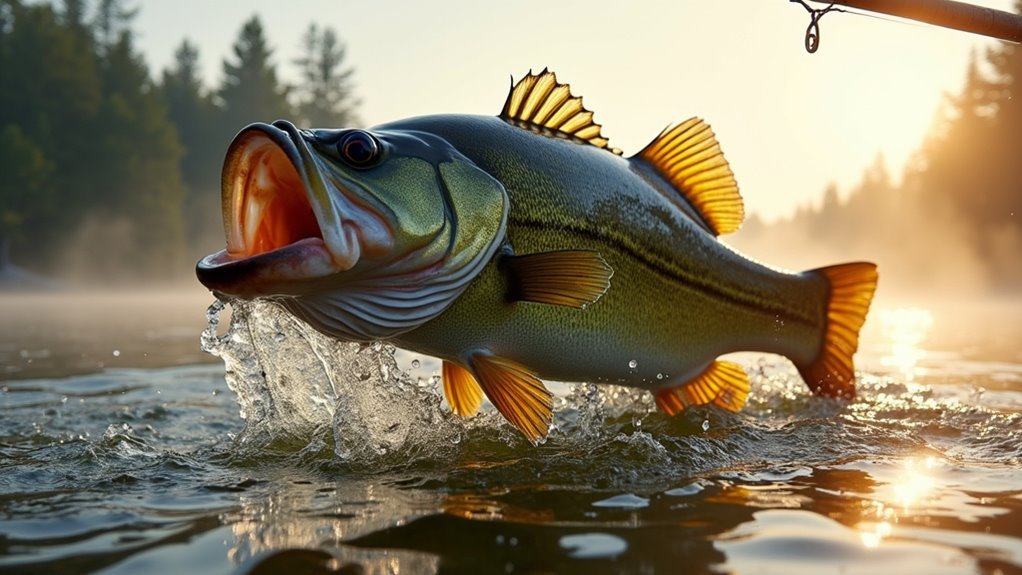
When it comes to largemouth bass fishing, the 22-pound club remains the most exclusive gathering in the angling world. Only three anglers have ever reached this milestone, and they’re practically legends around any fishing hole.
George Perry started it all back in 1932 with his 22-pound 4-ounce catch in Georgia. That record stood for 77 years until Manabu Kurita landed a bass just one ounce heavier in Japan’s Lake Biwa. Then there’s Robert Crupi, who joined the club with a 22-pounder at Castaic Lake in 1991.
We’ve spent countless dawns hoping for such monsters ourselves!
Southern California’s Trophy Bass Dominance
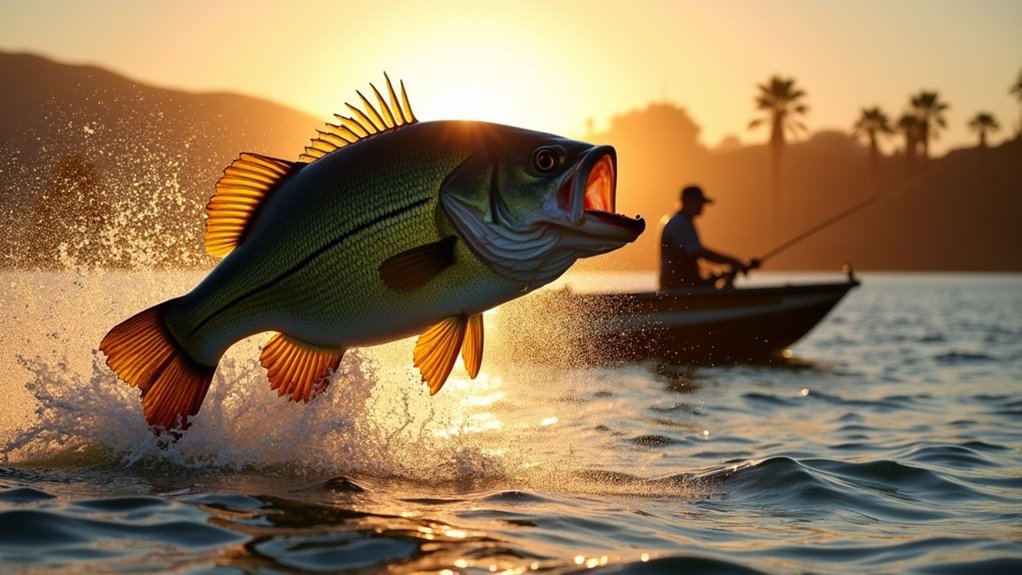
Southern California has become the undisputed heavyweight champion of trophy bass fishing since the late 1980s. We’ve seen an incredible run of monster catches that have fishing enthusiasts nationwide booking flights to SoCal.
| Angler | Weight | Location | Year |
|---|---|---|---|
| Crupi | 22 lbs | Castaic Lake | 1991 |
| Easley | 21 lb 3 oz | Oak View | 1980 |
| Hanline | 19 lb 2 oz | Morena Lake | 1989 |
| Kadota | 19 lbs | Castaic Lake | 1989 |
What’s their secret? These waters offer the perfect combo of warm climate, stocked Florida-strain bass, and year-round fishing conditions. We’ve fished these lakes ourselves and can tell you—the big girls are still there waiting!
Surprising Winter Bass Strategies That Paid Off
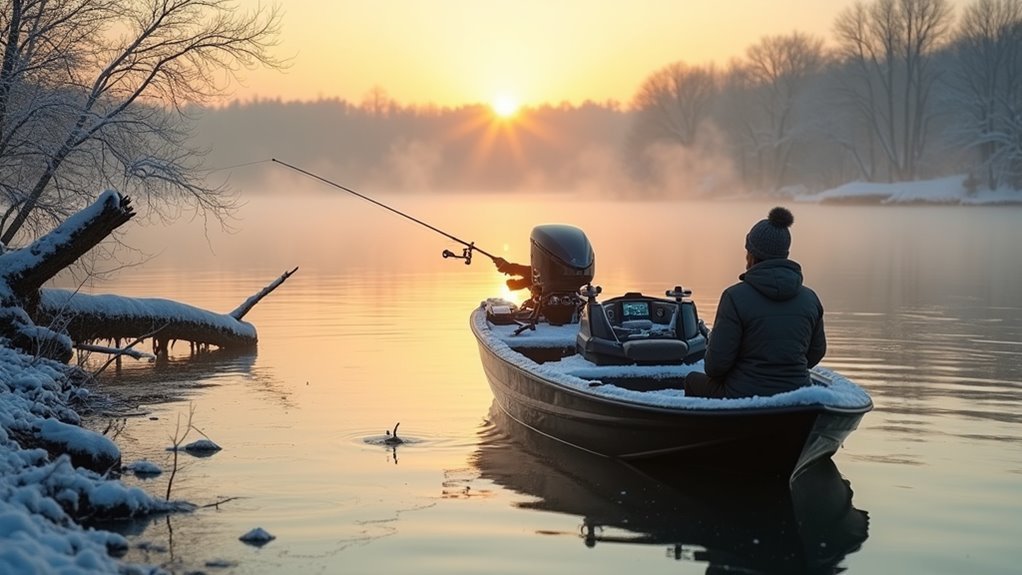
Although most anglers pack away their gear during the coldest months, winter can actually offer some of the year’s most rewarding bass fishing opportunities. Just look at Arden Charles Hanline’s impressive 19-pounder from Morena Lake and Dan Kadota’s matching catch at Castaic Lake—both landed in January 1989!
We’ve learned that winter bass often seek deeper, more stable water temperatures. Slower presentations work wonders, as these cold-water giants conserve energy. Robert Crupi proved this with his December monster caught on a simple herring jig. When everyone else is sitting at home, you might just land the trophy of a lifetime!
State Record Controversies and Violations
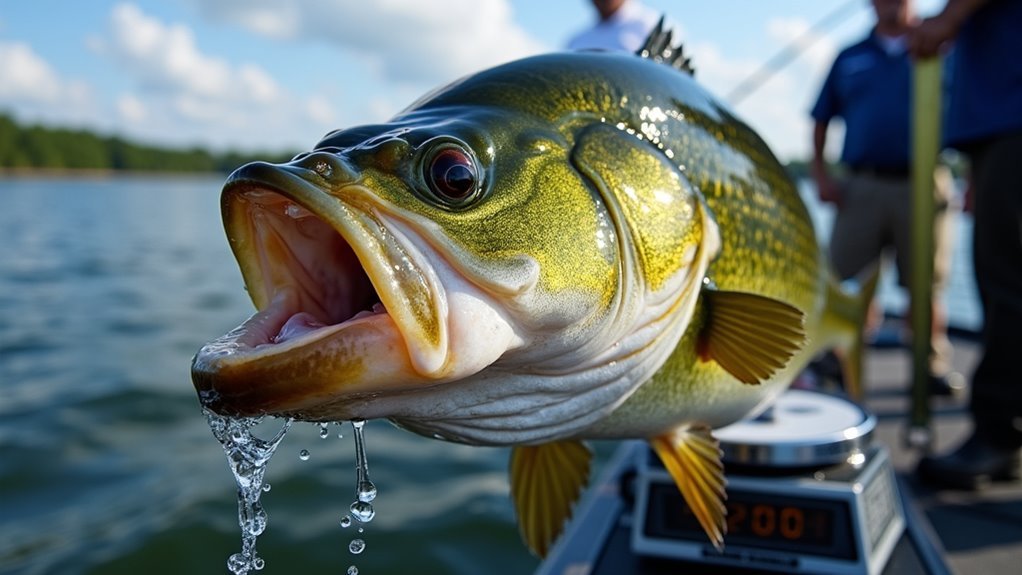
Not every record-breaking catch makes it into the official books. We’ve seen this firsthand with the Arkansas state record controversy, where a massive 17-03 bass caught on a trot line at Mallard Lake was disqualified. Why? The angler didn’t have a fishing license.
These situations pop up more than you’d think. We’ve watched trophy catches get rejected for improper documentation, illegal fishing methods, or boundary disputes. Remember when Kurita’s Japanese bass technically outweighed Perry’s by an ounce but didn’t count as a new world record? IGFA rules required a minimum two-ounce difference.
The fishing world has rules for good reason—conservation matters to all of us.
Evolution of Trophy Bass Fishing Techniques
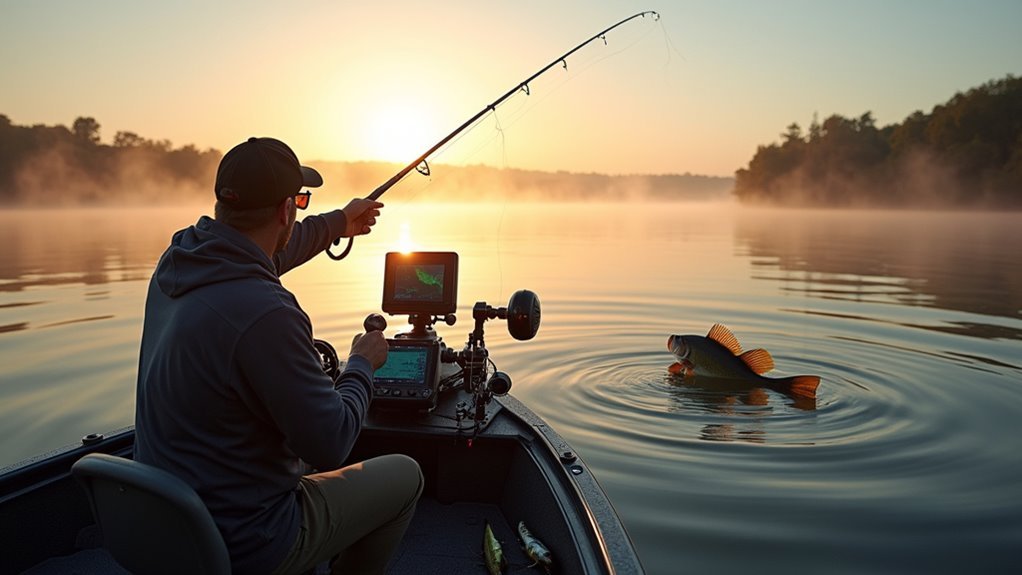
When George Perry landed his legendary 22-pound bass in 1932, he couldn’t have imagined how drastically bass fishing techniques would transform over the decades. We’ve seen anglers like Robert Crupi switch from simple bait to specialized approaches like using crayfish at Castaic Lake.
Today’s trophy hunters don’t just fish—they study water temperatures, use depth finders, and choose specific lures for different seasons. I remember when we’d just throw a worm and hope for the best! Now, it’s about understanding fish behavior, using lighter test lines (like Crupi’s 4-pound), and mastering techniques specific to deep-water bodies. Additionally, many anglers now rely on trolling motors to enhance their fishing efficiency and stealth while navigating waters.
Ray Scott’s Lasting Impact on Competitive Bass Fishing
As we mourn the passing of Ray Scott on May 8th, we’re reminded of how one man’s vision forever changed the landscape of bass fishing in America. Scott wasn’t just the founder of Bassmasters—he revolutionized how we think about bass fishing altogether.
His legacy lives on through:
Ray Scott’s vision elevated a pastime into a passion, transforming both the sport and the spirits of those who cast their lines.
- Creating the first professional bass tournaments that turned weekend anglers into celebrities
- Pioneering catch-and-release practices that conserve fish populations
- Establishing tournament rules that are now industry standards
- Building a community where fishing stories and techniques are shared freely
We’ve all benefited from his contributions to our beloved sport.
Frequently Asked Questions
How Do Changes in Water Temperature Affect Trophy Bass Behavior?
We’ve found that trophy bass become sluggish in cold water, moving deeper to find stable temperatures. In warmer water, they’re more active, feeding aggressively near the surface or shaded structure.
What Role Does Moon Phase Play in Record Largemouth Catches?
Over 70% of record catches occur during full or new moons. We’ve found moon phases intensify feeding activity through increased light and tidal forces. They’re especially effective when aligned with seasonal patterns and appropriate water temperatures.
Are Imported Bass Species Creating New Record Opportunities Worldwide?
We’re seeing imported largemouth bass creating new record opportunities globally. Japan’s Lake Biwa produced Manabu Kurita’s 22 lb 5 oz catch in 2009, demonstrating how introduced populations can thrive and rival historic American records.
How Have Electronics and Sonar Technology Changed Trophy Bass Fishing?
We’ve seen sonar and electronics revolutionize trophy bass fishing. They’ve given us the ability to locate fish in deep structures, track underwater movements, and identify prime habitat that was previously invisible to anglers.
Do Catch-And-Release Practices Improve the Odds of Record-Breaking Fish?
When Robert Crupi’s multiple catches at Castaic Lake happened, we’re seeing catch-and-release in action. We’ve found that releasing trophy bass absolutely improves record odds by allowing fish to grow larger for future anglers.
Conclusion
We’ve cast our lines across bass fishing’s most jaw-dropping moments, from Perry’s depression-era whopper to today’s trophy hunters. Like fish to a perfectly placed lure, we’re drawn to these stories that shimmer with possibility. Whether you’re dreaming of breaking records or just enjoying a peaceful day on the water, remember—every angler’s journey has its ripples of excitement. The big ones are still out there, waiting for you to make history.